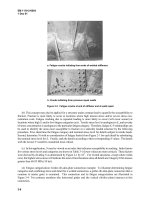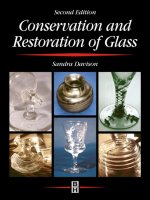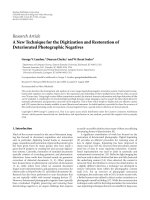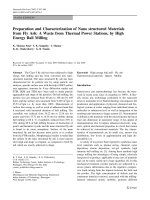Prervation and restoration of tooth structure
Bạn đang xem bản rút gọn của tài liệu. Xem và tải ngay bản đầy đủ của tài liệu tại đây (22.03 MB, 621 trang )
introduction to the
preservation and restoration
of tooth structure
an
prepared and edited by
Dr. Graham J Mount
continue
Preservation and restoration of tooth structure
please choose a chapter
Each chapter has a series of photographs that supplement the
text and illustrations in this book.
By double clicking on the folder
symbol (see the icon below) you
will be able to read a caption or
commentary for that picture.
1
2
3
4
5
6
7
8
9
10
11
12
13
15
18
19
20
21
22
Tooth structure
The nature and progression of dental caries
Management and control of caries
Non-carious changes to tooth crowns
Disease dynamics of the dental pulp
Cutting instruments used in tooth restoration
Basic principles for restorative dentistry
Glass ionomer materials
Composite resins
Dental amalgam
Tooth preparation for restoration with plastic materials
Rigid materials used in tooth restoration
Tooth preparation for restoration with rigid materials
Restoration of aesthetics in anterior teeth
Vital pulp therapy
Restoration of pulpless teeth
Periodontal considerations in tooth restoration
Occlusion as it relates to restoration of individual teeth
Failures of individual restorations and their management
Chapter 1 : Tooth structure
Authors : WR Hume, GC Townsend
It is essential to have a good understanding of tooth structure in order to understand both the
nature of the defects and the diseases that can occur and to then make rational decisions on
their prevention, treatment and repair.
Teeth are composed of four different tissues : enamel, dentine, dental pulp and cementum.
Each of these is made up of structural elements found elsewhere in the body, but arranged in
unique ways.
In the brief description that follows, a basic knowledge of the embryology and histology of the
developing tooth is assumed. Readers interested in further information are referred to the
reading list at the end of this chapter.
Each chapter has a series of photographs that supplement the text and illustrations in
this book. By double clicking on the folder symbol (see the icon at right) you will be
able to read a caption or commentary for that picture.
To go to the next image, click once on the
red button. At the end of a sequence this
button will return you to the chapter menu.
Chapter 2 : The nature and progression of dental caries
Author : JW McIntyre
This chapter emphasises the modern concept of dental caries. For many years it was thought to
be a one way, progressive demineralisation of the enamel crystallites followed by degeneration of
dentine, leading to cavity formation. Theories concerning the actual cause of the degradation
have varied but it has always been regarded as primarily of bacterial origin.
In the present concept, the emphasis is on a demineralisation/remineralisation cycle of the
chemical reaction that occur on tooth structure. This model assists the dentist to guide the
patient to independently maintain a high level of control over the disease.
This approach is not inconsistent with models which focus on the concept of caries as an
infectious disease. However, the demin/remin approach provides greater emphasis on the
aspect of enhancement of the natural host protective factors rather than simply aiming to control
bacterial plaque infection.
Each chapter has a series of photographs that supplement the text and illustrations in
this book. By double clicking on the folder symbol (see the icon at right) you will be
able to read a caption or commentary for that picture.
To go to the next image, click once on the
red button. At the end of a sequence this
button will return you to the chapter menu.
Chapter 3 : Management and control of caries
Author : JW McIntyre
Using an understanding of the demin/remin cycle discussed in the previous chapter, patients can
be advised on strategies to prevent or reverse the problem. It is necessary to determine for each
patient which is the dominant factor or factors causing the disease. It could be a highly cariogenic
diet, poor plaque control or a serious depletion of natural protective factors causing an otherwise
acceptable diet to result in caries.
Irrespective of the cause, it will be necessary first to educate the patient and then to gain control
by either :
- reducing the demineralisation process
- enhancing the protective factors
Each chapter has a series of photographs that supplement the text and illustrations in
this book. By double clicking on the folder symbol (see the icon at right) you will be
able to read a caption or commentary for that picture.
To go to the next image, click once on the
red button. At the end of a sequence this
button will return you to the chapter menu.
Chapter 4 : Non-carious changes to tooth crowns
Authors : JA Kaidonis, LG Richards, GC Townsend
Apart from dental caries and iatrogenic modification such as cavity preparation by a dentist, the main processes that
can change the morphology of a tooth during its lifetime are abrasion, attrition, erosion and fracture. Modern
dentistry has evolved into an art and science aimed at restoring the broken down dentition to its newly-erupted
morphology on the assumption that the unworn tooth has the ideal functional form.
A variety of geometric concepts of occlusion have evolved over the years and occlusal reconstruction has tended to
follow formal guidelines regardless of the great variabiity that exists in the architecture of the stomatognathic system
within, and between, populations as well as in the same individual over time. Fossil records, anthropopological
research and studies in comparative anatomy, show that the processes responsible for tooth reduction have acted
on teeth since prehistoric times. It is therefore reasonable to recognise and accept tooth wear as a normal
physiological process, no different from aging. Changes to masticatory structures as a consequence of wear often
represent adaptation and not pathology. Only when the adaptive capabilities of the individual are surpassed will
pathology become evident.
This broader concept modifies to some degree, the philosophy of clinical dentistry. By recognizing progressive
change in tooth form as a physiologically dynamic process, premature and unnecessary dental intervention may be
avoided.
Each chapter has a series of photographs that supplement the text and illustrations in
this book. By double clicking on the folder symbol (see the icon at right) you will be
able to read a caption or commentary for that picture.
To go to the next image, click once on the
red button. At the end of a sequence this
button will return you to the chapter menu.
Chapter 5 : Disease dynamics of the dental pulp
Authors : WR Hume, WLK Massey
An understanding of the events which occur in the pulp following insults enables the dentist to both protect the
tissue, and to provide appropriate treatment when it is damaged. Interceptive therapy may make the difference
between pulp survival through healing and pulp death. Various therapies may also reduce or eliminate pulpal pain.
In very general terms, the pulp responds to damage in ways similar to the other connective tissues, i.e. it can
undergo various forms of inflammation, it can heal, or it can die. However, the pulp is unique among connective
tissues in that it is entirely enclosed in dentine and it has processes which extend throughout the dentine so that
pulp and the dentine should be regarded as a single entity.
Any trauma or therapy applied to the dentine should be regarded as trauma or therapy applied to the pulp. Insults,
such as the caries process and tooth restoration, are unlike those found elsewhere in the body and will change the
pulp. It is not surprising therefore, that some aspects of the pulps response to insults are unique. Some therapies
used to treat the dental pulp are also unique.
Each chapter has a series of photographs that supplement the text and illustrations in
this book. By double clicking on the folder symbol (see the icon at right) you will be
able to read a caption or commentary for that picture.
To go to the next image, click once on the
red button. At the end of a sequence this
button will return you to the chapter menu.
Chapter 6 : Cutting instruments used in tooth restoration
Author : GJ Mount
The stage may be reached in the progression of dental caries where preventative therapy and
remineralisation techniques will no longer be successful. In the presence of frank cavitation in both
enamel and dentine, it will no longer be possible to eliminate plaque. It then becomes necessary
to surgically debride the lesion and restore the tooth to original anatomy to prevent further
breakdown. It is also necessary to shape and restore broken teeth and to remove defective
restorations and replace them. Each of these actions requires cutting the tooth tissues or hard
restorative materials.
Enamel is the hardest material in the body. Some restorative materials are of similar hardness and
dentine is only a little softer. Rotating cutting instruments travelling at various speeds are the most
effective means of reducing both tooth tissue and restorative material. However, refinement of
cavity margins is not always possible with rotary instruments because of difficulties of access and
final removal of softened carious dentine may be best carried out using a degree of tactile sense.
Under these circumstances hand instruments remain useful.
Each chapter has a series of photographs that supplement the text and illustrations in
this book. By double clicking on the folder symbol (see the icon at right) you will be
able to read a caption or commentary for that picture.
To go to the next image, click once on the
red button. At the end of a sequence this
button will return you to the chapter menu.
Chapter 7 : Basic principles for restorative dentistry
Author : GJ Mount
When a carious lesion has progressed to the point where it is not possible to
remineralise, it is necessary to remove that part which is broken down and place
a restorative material. This chapter discusses the basic principles which must be
understood to ensure proper placement and retention of the various restorative
materials available.
No material is universal, and correct selection is important to ensure longevity.
In the following chapters these materials will be discussed in sufficient detail to
enable the clinician to make a logical choice as to which material to select for
each restorative problem.
Each chapter has a series of photographs that supplement the text and illustrations in
this book. By double clicking on the folder symbol (see the icon at right) you will be
able to read a caption or commentary for that picture.
To go to the next image, click once on the
red button. At the end of a sequence this
button will return you to the chapter menu.
Chapter 7 : Basic principles for restorative dentistry
Author : GJ Mount
Adhesion
There are essentially two types of adhesion available in the oral cavity. A micro-technical union can be readily
developed between composite resin and enamel simply by etching the enamel and applying an unfilled resin. A
similar union has been attempted with dentine but there remains some doubt about the the longevity because
of the presence of a positive dentine fluid flow.
A chemical union can be developed between the hard tooth tissues and glass ionomer materials because of the
polyalkenoic acids which provide an ion exchange as well as a chemical union with collagen. A similar adhesion
with composite resin is being explored.
Retention
In the absence of adhesion there needs to be some form of mechanical interlocking between the restoration
and the tooth structure. This is generally provided through the use of ditches and grooves but occasionally
self-threading pins may be indicated.
Protection
As the cavity enlarges the strength of the remaining tooth structure becomes compromised and it may be
necessary to offer some degree of protection against the future development of cracks at the base of a cusp.
Each chapter has a series of photographs that supplement the text and illustrations in
this book. By double clicking on the folder symbol (see the icon at right) you will be
able to read a caption or commentary for that picture.
To go to the next image, click once on the
red button. At the end of a sequence this
button will return you to the chapter menu.
Chapter 8 : Glass-ionomer materials
Authors : GJ Mount, RW Bryant
Glass-ionomer was developed in England and was first reported by Wilson and Kent in 1972. At
that time it was recommended for the restoration of Class V abrasion lesions but the early
versions lacked aesthetics and translucency. Subsequent development and research by the
manufacturers has evolved a number of very useful materials in this class which can be used for a
variety of functions in restorative dentistry including luting restorative materials, lining and basing
cavities prior to the placement of other restorative materials as well as a an aesthetic translucent
restoration in its own right. Since their development, glass-ionomers have increasingly become an
essential part of the dentists armamentarium for providing treatment that conserves tooth
atructure and assists in its remineralisation and at the same time maintains aesthetics.
Of the glass-ionomers numerous attractive characteristics, the most significant are the ability to
bond chemically to dentine and enamel through an ion exchange mechanism; long-term flouride
release without high solubility; and the ability to re-absorb flouride ions and therefore act as a
flouride reservoir. The principal negative feature at this point, is susceptability to brittle fracture the material is unable to withstand undue occlusal/incisal loading.
Each chapter has a series of photographs that supplement the text and illustrations in
this book. By double clicking on the folder symbol (see the icon at right) you will be
able to read a caption or commentary for that picture.
To go to the next image, click once on the
red button. At the end of a sequence this
button will return you to the chapter menu.
Chapter 8 : Glass-ionomer materials
(continued)
Authors : GJ Mount, RW Bryant
Glass-ionomers
This section deals with the detail of the basic properties and clinical handling of glass-ionomer materials. It is
essential that they be properly understood if they are to succeed in the oral environment. The basic rules
are not difficult and they can be very useful as long as they are not subject to undue occlusal load.
Type II.2 restorative reinforced
The type II.2 glass-ionomers identify the reinforced restorative classification which to date have been
represented mainly by the so-called cermets. These materials have a layer of fine silver particles sintered to
the surface of the glass particles leading to an enhanced wear resistance. In future the new auto-cure cements
with high physical properties are more likely to be used in situations where the cermets have been used
innthe past.
Lamination
Because the fracture resistance of the glass-ionomers is limited, it is necessary on occasion to support and
protect them against undue occlusal load. Also, the ion exchange with dentine is at present the preferred
method for providing adhesion between composite resin and dentine.
Each chapter has a series of photographs that supplement the text and illustrations in
this book. By double clicking on the folder symbol (see the icon at right) you will be
able to read a caption or commentary for that picture.
To go to the next image, click once on the
red button. At the end of a sequence this
button will return you to the chapter menu.









